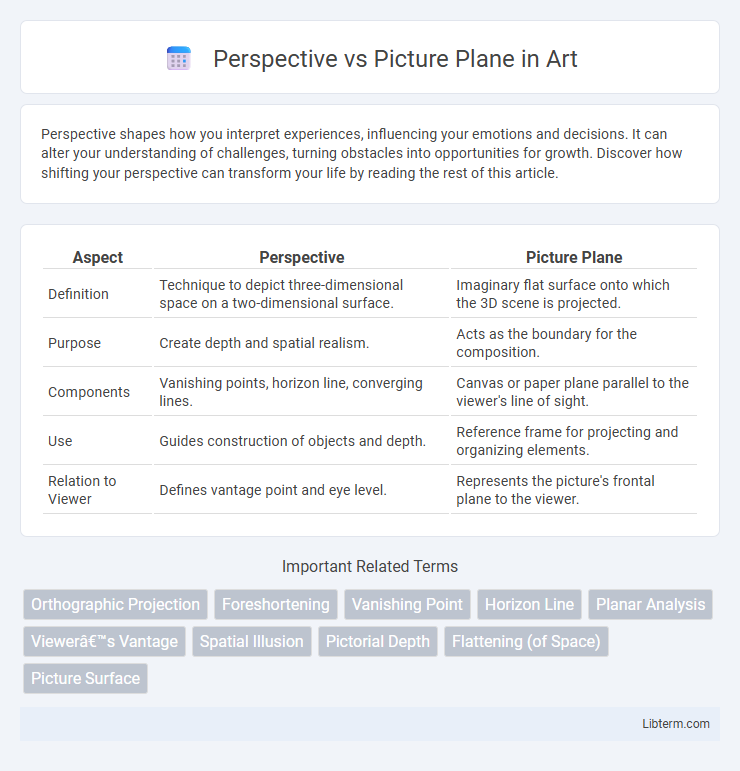Perspective shapes how you interpret experiences, influencing your emotions and decisions. It can alter your understanding of challenges, turning obstacles into opportunities for growth. Discover how shifting your perspective can transform your life by reading the rest of this article.
Table of Comparison
| Aspect | Perspective | Picture Plane |
|---|---|---|
| Definition | Technique to depict three-dimensional space on a two-dimensional surface. | Imaginary flat surface onto which the 3D scene is projected. |
| Purpose | Create depth and spatial realism. | Acts as the boundary for the composition. |
| Components | Vanishing points, horizon line, converging lines. | Canvas or paper plane parallel to the viewer's line of sight. |
| Use | Guides construction of objects and depth. | Reference frame for projecting and organizing elements. |
| Relation to Viewer | Defines vantage point and eye level. | Represents the picture's frontal plane to the viewer. |
Understanding Perspective in Art
Perspective in art refers to the technique used to represent three-dimensional objects on a two-dimensional surface, creating the illusion of depth and spatial relationships. The picture plane is the flat, two-dimensional surface on which the artwork is created, serving as the boundary between the viewer and the depicted scene. Understanding perspective involves mastering concepts like vanishing points, horizon lines, and foreshortening to accurately depict spatial depth within the constraints of the picture plane.
Defining the Picture Plane
The picture plane is an imaginary, flat surface that acts as the boundary between the viewer and the artwork, serving as the window through which the scene is observed. It is a crucial element in linear perspective, defining the two-dimensional space where the three-dimensional illusion is created by projecting objects. Understanding the picture plane allows artists to accurately depict depth, scale, and spatial relationships within a composition.
Historical Evolution of Perspective
The historical evolution of perspective began in the early Renaissance with Filippo Brunelleschi's pioneering experiments in linear perspective, establishing the picture plane as a crucial conceptual tool for representing spatial depth on a flat surface. Artists like Leon Battista Alberti formalized the mathematical rules governing vanishing points and horizon lines, transforming the picture plane into a disciplined framework for creating realistic images. This development shifted artistic representation from flat, symbolic forms to immersive three-dimensional illusions, deeply influencing subsequent Western art and visual culture.
The Role of the Picture Plane in Composition
The picture plane serves as the two-dimensional surface on which an artist constructs the visual composition, establishing the boundary between the artwork and the viewer's space. It functions as a conceptual window that organizes spatial relationships through perspective techniques, guiding the placement and proportion of elements to create depth and illusion. By controlling the picture plane, artists manipulate visual tension and balance, enhancing the overall impact and clarity of the composition.
Perspective Techniques and Methods
Perspective techniques involve creating the illusion of depth and spatial relationships on a flat surface by using vanishing points, horizon lines, and converging lines to represent three-dimensional objects accurately. Picture plane methods focus on the flat surface upon which the image is drawn or painted, serving as a transparent window through which the scene is projected, ensuring proportionality and alignment. Mastering one-point, two-point, and atmospheric perspective methods enhances the realistic depiction of volume, distance, and scale within the picture plane.
Picture Plane: Window vs. Surface
The picture plane serves as the fundamental two-dimensional surface where artistic images are created, acting either as a transparent "window" into a three-dimensional world or as a flat "surface" emphasizing the artwork's materiality. When treated as a window, the picture plane invites viewers to perceive depth and spatial relationships through linear perspective, mimicking visual reality. In contrast, viewing the picture plane as a surface highlights the painting's textures, colors, and shapes, reinforcing the artwork's flatness and the artist's deliberate manipulation of its elements.
Interplay Between Perspective and Picture Plane
The interplay between perspective and picture plane shapes the illusion of depth within a two-dimensional artwork by aligning the viewer's vantage point with the flat surface of the canvas. Perspective techniques manipulate spatial relationships and vanishing points on the picture plane, allowing artists to simulate three-dimensionality on a flat medium. This dynamic interaction defines how the depicted scene conveys realism and spatial order through precise geometric construction.
Visual Illusion: Depth vs. Flatness
Perspective creates a visual illusion of depth by simulating three-dimensional space on a two-dimensional picture plane, using techniques like converging lines and varying scale. The picture plane itself remains flat, serving as the surface where the illusion of depth is constructed through careful manipulation of spatial cues. This contrast highlights how artists translate three-dimensional reality into flat images, challenging the viewer's perception of space.
Applications in Contemporary Art
Perspective techniques create depth and spatial realism, essential for immersive installations and virtual reality art in contemporary practice. Picture plane manipulations emphasize flatness and surface, influencing abstract and pop art movements that challenge traditional visual narratives. Artists leverage the tension between perspective and picture plane to explore perception, space, and viewer engagement in multimedia and conceptual artworks.
Mastering Perspective and Picture Plane in Practice
Mastering perspective and picture plane in practice enhances spatial accuracy and depth representation in art, crucial for creating realistic scenes. Understanding how the picture plane acts as a window through which three-dimensional objects are projected helps artists manipulate vanishing points and horizon lines effectively. Consistent practice with perspective grids and observational drawing refines an artist's ability to translate complex forms onto a flat surface, strengthening their compositional skills.
Perspective Infographic

 libterm.com
libterm.com